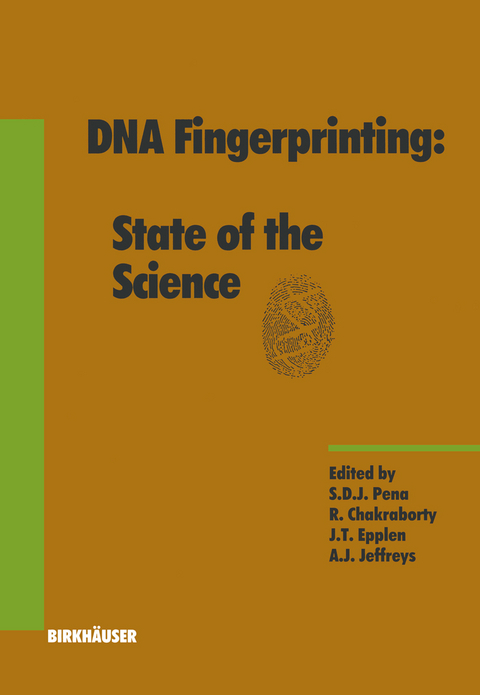
DNA Fingerprinting: State of the Science
Springer Basel (Verlag)
978-3-7643-2906-8 (ISBN)
I Basic Aspects of DNA Fingerprints: Genomic Organization, Dynamics and Variability of Tandemly Repeated DNA Sequences.- 1 Brief introduction to human DNA fingerprinting.- 1 Notes on the definition and nomenclature of tandemly repetitive DNA sequences.- 2 On the essence of "meaningless" simple repetitive DNA in eukaryote genomes.- 3 Detection, cloning, and distribution of minisatellites in some mammalian genomes.- 4 Frequency of restriction site polymorphisms in the region surrounding VNTR loci.- 5 Human VNTR mutation and sex.- 6 Variation of minisatellites in chemically induced mutagenesis and in gene amplification 71.- 7 Iterons of stringently controlled plasmids and DNA fingerprinting.- 2 Arbitrary primed PCR fingerprinting of RNA applied to mapping differentially expressed genes.- 3 Rapid analysis of PCR components and products by acidic non-gel capillary electrophoresis.- II Application of DNA Fingerprinting to the Study of Human Populations.- 1 Minisatellite variant repeat mapping: Application to DNA typing and mutation analysis.- 2 Microsatellites and disease: A new paradigm.- 1 A unified approach to study hypervariable polymorphisms: Statistical considerationsof determining relatedness and population distances.- 2 The forensic significance of various reference population databases for estimating the rarity of variable number of tandem repeat (VNTR) loci profiles.- 3 Population genetics of 14 ethnic groups using phenotypic data from VNTR loci.- 4 Genetic variation among the Mapuche Indians from the Patagonian region of Argentina: Mitochondrial DNA sequence variation and allele frequencies of several nuclear genes.- 5 Microsatellite and HLA class II oligonucleotide typing in a population of Yanomami Indians.- 6 Iserables: A Bedouin village in Switzerland?.- 1Paternity testing with the F10 multilocus DNA fingerprinting probe.- 2 The formal analysis of multilocus DNA fingerprints.- 3 Oligonucleotide DNA fingerprinting: Results of a multi-center study on reliability and validity.- 4 Testing deficiency paternity cases with a Y-linked tetranucleotide repeat polymorphism.- 5 Short tandem repeat loci: Application to forensic and human remains identification.- 6 Forensic DNA typing by the solid-phase minisequencing method.- 7 The use of polymorphic Alu insertions in human DNA fingerprinting.- III Application of DNA Fingerprinting to the Study of Microorganisms, Plants, and Animals.- 1 Applications of DNA fingerprinting in plant population studies.- 1 DNA- and PCR-fingerprinting in fungi.- 2 DNA fingerprinting reveals relationships between strains of Trypanosoma rangeli and Trypanosoma cruzi.- 3 The use of RAPDs for the analysis of parasites.- 4 The use of RAPDs for the study of the genetic diversity of Schistosoma mansoni and Trypanosoma cruzi.- 5 Variability and intra nest genetic relationships in Hymenoptera: DNA fingerprinting applied to the solitary bee Megachille rotundat.- 6 Sperm utilization in honeybees as detected by Ml3 DNA fingerprints.- 1 High mating success of low rank males in Limia perugiae (Pisces: Poeciliidae) as determined by DNA fingerprinting.- 2 Quantitative traits in chicken associated with DNA fingerprint bands.- 3 Influence of extra-pair paternity on parental care in great tits (Parus major).- 4 Paternity testing of endangered species of birds by DNA fingerprinting with non-radioactive labelled oligonucleotide probes.- 5 Characterization and applications of multilocus DNA fingerprints in Brazilian endangered macaws.- 1 DNA fingerprinting of trait-selected mouse lines and linkage analysis in reference families.- 2 Dog genetic polymorphism revealed by synthetic tandem repeats.- 3 Characterization of canine microsatellites.- 4 Application of human minisatellite probes to the development of informative DNA fingerprints and the isolation of locusspecific markers in animals.- 5 The 'individualization' of large North American mammals.- 6 Bovine microsatellites: Racial differences and association with SINE-elements.- 7 Oligonucleotide fingerprinting of free-ranging and captive rhesus macaques from Cayo Santiago: Paternity assignment and comparison of heterozygosity.- 8 Use of highly repeated DNA polymorphisms for genome diagnosis and evolutionary studies in the genus Beta.
| Erscheint lt. Verlag | 1.7.1993 |
|---|---|
| Reihe/Serie | Experientia Supplementum |
| Zusatzinfo | XI, 468 p. |
| Verlagsort | Basel |
| Sprache | englisch |
| Maße | 170 x 244 mm |
| Gewicht | 995 g |
| Themenwelt | Medizin / Pharmazie ► Medizinische Fachgebiete |
| Studium ► 2. Studienabschnitt (Klinik) ► Rechtsmedizin | |
| Naturwissenschaften | |
| Sozialwissenschaften | |
| Schlagworte | Databases • Evolution • Fungi • Genetics • Genetischer Fingerabdruck • Gentechnologie • Hardcover, Softcover / Naturwissenschaften allgemein • HC/Naturwissenschaften allgemein • Microorganism • Nature • organization • Rechtsmedizin |
| ISBN-10 | 3-7643-2906-8 / 3764329068 |
| ISBN-13 | 978-3-7643-2906-8 / 9783764329068 |
| Zustand | Neuware |
| Haben Sie eine Frage zum Produkt? |
aus dem Bereich


